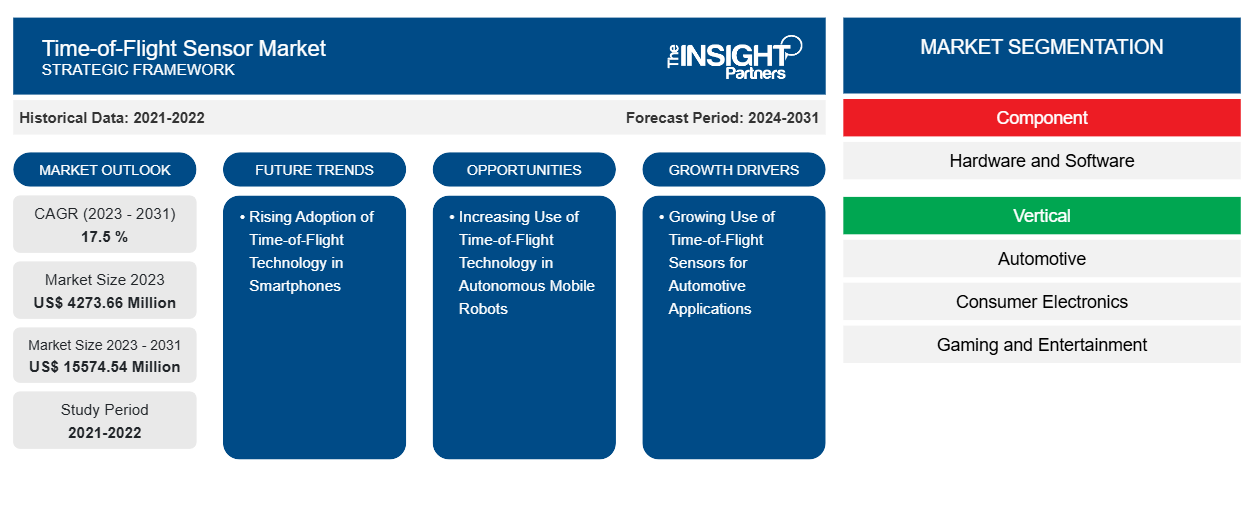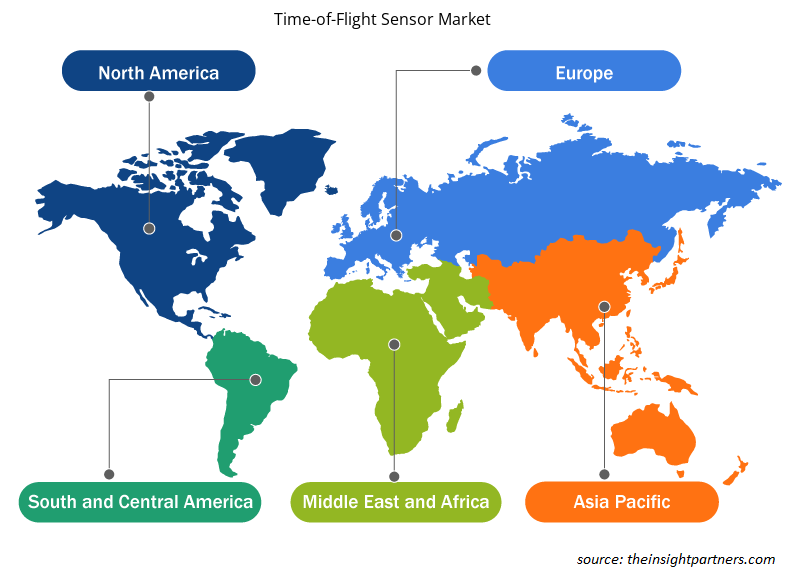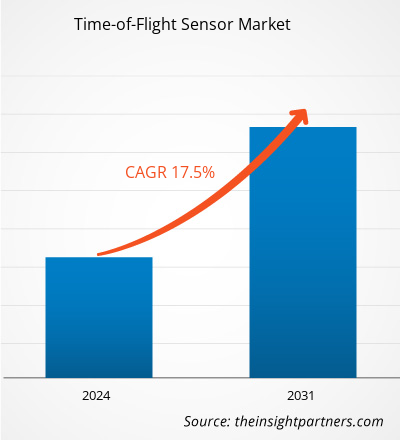The time-of-flight sensor market size is projected to reach US$ 15574.54 million by 2031 from US$ 4273.66 million in 2023. The market is expected to register a CAGR of 17.5 % during 2023–2031. Rising adoption of time-of-flight technology in smartphones is likely to remain a key trend in the market.
Time-of-Flight Sensor Market Analysis
The demand for ToF sensors is increasing due to their rising use in the automotive industry. The technology is used to monitor the driver's behavior, which helps prevent road accidents and improve vehicle safety. In addition, the demand for the sensors is increasing in other industries, such as consumer electronics, healthcare, gaming & entertainment, and aerospace & defense. As a result, the market players are coming up with advanced ToF sensors. In February 2020, Panasonic Corporation announced that they had developed a time-of-flight image sensor that uses avalanche photodiode (APD) pixels. It can acquire highly accurate 3D information according to the position of objects from near to far distances up to 250 m. These sensors can be applied in various fields, such as automotive range imaging and wide-area surveillance.
Time-of-Flight Sensor Market Overview
Time-of-flight (ToF) sensors are used to measure the time taken by an object to travel a distance through a medium. It calculates the time difference between the emission of a signal and its return to the sensor after being reflected by an object. The sensor is used for various applications, including robot navigation, people counting, vehicle monitoring, and object detection. It is an all-in-one system for cost-effective, easy, and small-footprint integration. It provides true distance measurement without depending on the target size, color, and reflectance. In addition, ToF sensors use lasers to measure long distances and range with great precision.
Customize This Report To Suit Your Requirement
You will get customization on any report - free of charge - including parts of this report, or country-level analysis, Excel Data pack, as well as avail great offers and discounts for start-ups & universities
Time-of-Flight Sensor Market: Strategic Insights

- Get Top Key Market Trends of this report.This FREE sample will include data analysis, ranging from market trends to estimates and forecasts.
You will get customization on any report - free of charge - including parts of this report, or country-level analysis, Excel Data pack, as well as avail great offers and discounts for start-ups & universities
Time-of-Flight Sensor Market: Strategic Insights

- Get Top Key Market Trends of this report.This FREE sample will include data analysis, ranging from market trends to estimates and forecasts.
Time-of-Flight Sensor Market Drivers and Opportunities
Growing Use of Time-of-Flight Sensors for Automotive Applications
Along with the developments in vehicle safety, the ToF technology offers convenience and comfort inside the car cabin, which may benefit drivers and passengers. The seats can be moved, and seat belts can be brought closer when the passenger gets into the car. It can also help the driver or passenger by turning on the light of the storage compartments when a hand reaches in that direction. Thus, the increasing use of ToF sensors for automotive applications is boosting the growth of the time-of-flight sensor market.
Increasing Use of Time-of-Flight Technology in Autonomous Mobile Robots
In warehouse operations, time-of-flight cameras can provide superior intelligence for Autonomous Mobile Robots (AMRs) and Automated Guided Vehicles (AGVs). The cameras can be used to observe the surroundings and capture depth imaging data, which further enhances business-critical functions with accuracy, convenience, and speed. The camera has various functions such as localization, mapping, obstacle avoidance, navigation, object detection, and odometry. The demand for time-of-flight cameras is increasing, enabling the market players to obtain technologically advanced time-of-flight cameras. Thus, such innovations by the market participants and the increasing adoption of time-of-flight sensors in AMRs are creating create lucrative opportunities for the time-of-flight sensors market.
Time-of-Flight Sensor Market Report Segmentation Analysis
Key segments that contributed to the derivation of the time-of-flight sensor market analysis are device type and vertical.
- Based on the device type, the time-of-flight sensor market is divided into RF-modulated light sources with phase detectors, range-gated imagers, direct time-of-flight imagers. The software segment held a larger market share in 2023.
- By vertical, the market is segmented into automotive, consumer electronics, gaming and entertainment, industrial, healthcare, aerospace and defense, others.
Time-of-Flight Sensor Market Share Analysis by Geography
The geographic scope of the time-of-flight sensor market report is mainly divided into five regions: North America, Asia Pacific, Europe, Middle East & Africa, and South & Central America. The North American market is attributed to the growing demand for time-of-flight (ToF) sensors in automotive and consumer electronics applications. Some of the safety functions offered by the ToF camera are NCAP-mandated driver fatigue detection, body pose, eye gaze, hands-on-wheel detection, advanced seat-belt application, and head pose. The safety function of the time-of-flight sensor is beneficial for road accidents. Due to the increasing awareness of safety functions, the demand for vehicles integrated with the ToF camera is rising in the North American region.
Time-of-Flight Sensor Market Regional Insights
The regional trends and factors influencing the Time-of-Flight Sensor Market throughout the forecast period have been thoroughly explained by the analysts at The Insight Partners. This section also discusses Time-of-Flight Sensor Market segments and geography across North America, Europe, Asia Pacific, Middle East and Africa, and South and Central America.

- Get the Regional Specific Data for Time-of-Flight Sensor Market
Time-of-Flight Sensor Market Report Scope
| Report Attribute | Details |
|---|---|
| Market size in 2023 | US$ 4273.66 Million |
| Market Size by 2031 | US$ 15574.54 Million |
| Global CAGR (2023 - 2031) | 17.5 % |
| Historical Data | 2021-2022 |
| Forecast period | 2024-2031 |
| Segments Covered |
By Component
|
| Regions and Countries Covered | North America
|
| Market leaders and key company profiles |
Time-of-Flight Sensor Market Players Density: Understanding Its Impact on Business Dynamics
The Time-of-Flight Sensor Market is growing rapidly, driven by increasing end-user demand due to factors such as evolving consumer preferences, technological advancements, and greater awareness of the product's benefits. As demand rises, businesses are expanding their offerings, innovating to meet consumer needs, and capitalizing on emerging trends, which further fuels market growth.
Market players density refers to the distribution of firms or companies operating within a particular market or industry. It indicates how many competitors (market players) are present in a given market space relative to its size or total market value.
Major Companies operating in the Time-of-Flight Sensor Market are:
- OMRON Corp
- STMicroelectronics NV
- Keyence Corp
- Teledyne e2v (Overseas)
- Holdings Ltd
- Texas Instruments Inc
Disclaimer: The companies listed above are not ranked in any particular order.

- Get the Time-of-Flight Sensor Market top key players overview
Time-of-Flight Sensor Market News and Recent Developments
The time-of-flight sensor market is evaluated by gathering qualitative and quantitative data post primary and secondary research, which includes important corporate publications, association data, and databases. A few of the developments in the time-of-flight sensor market are listed below:
- STMicroelectronics introduced new high-resolution time-of-flight sensors for advanced 3D depth imaging for smartphones and other devices. The VD55H1 sensor maps 3D surfaces by measuring the distance to approximately half a million points and enables detection of objects up to 5 m from the sensor.(Source: STMicroelectronics, Press Release, MArch 2022.)
- TDK Corporation launched the Chirp ICU-10201 and ICU-20201, ultra-low power and high-performance integrated ultrasonic time-of-flight sensors for long and short range detection. The company states that new MEMS sensors offer accurate range measurements up to a distance of 5 m over a wide and configurable field of view. (Source: TDK Corporation, Press Release, January 2022)
Time-of-Flight Sensor Market Report Coverage and Deliverables
The “Time-of-Flight Sensor Market Size and Forecast (2021–2031)” report provides a detailed analysis of the market covering below areas:
- Time-of-flight sensor market size and forecast at global, regional, and country levels for all the key market segments covered under the scope
- Time-of-flight sensor market trends as well as market dynamics such as drivers, restraints, and key opportunities
- Detailed PEST/Porter’s Five Forces and SWOT analysis
- time-of-flight sensor market analysis covering key market trends, global and regional framework, major players, regulations, and recent market developments
- Industry landscape and competition analysis covering market concentration, heat map analysis, prominent players, and recent developments for the time-of-flight sensor market
- Detailed company profiles
Frequently Asked Questions
What is the expected CAGR of the time-of-flight sensor market?
The expected CAGR of the global time-of-flight sensor market is 17.5 %.
What would be the estimated value of the time-of-flight sensor market by 2031?
The global time-of-flight sensor market is expected to reach US$ 15574.54 million by 2031.
Which are the leading players operating in the time-of-flight sensor market?
The key players holding majority shares in the global time-of-flight sensor market are OMRON Corp, STMicroelectronics NV, Keyence Corp, Teledyne e2v (Overseas), Holdings Ltd, Texas Instruments Inc, InvenSense Inc, Panasonic Holdings Corp, Analog Devices Inc, Sony Group Corp, and Infineon Technologies AG.
What are the future trends of the time-of-flight sensor market?
Rising adoption of time-of-flight technology in smartphones is anticipated to play a significant role in the global time-of-flight sensor market in the coming years.
What are the driving factors impacting the time-of-flight sensor market?
Growing use of time-of-flight sensors for automotive applications and increasing use of time-of-flight technology in autonomous mobile robots are the major factors that propel the global time-of-flight sensor market.
Which region dominated the time-of-flight sensor market in 2023?
North America dominates the time-of-flight sensor market.
- Historical Analysis (2 Years), Base Year, Forecast (7 Years) with CAGR
- PEST and SWOT Analysis
- Market Size Value / Volume - Global, Regional, Country
- Industry and Competitive Landscape
- Excel Dataset
Testimonials
Reason to Buy
- Informed Decision-Making
- Understanding Market Dynamics
- Competitive Analysis
- Identifying Emerging Markets
- Customer Insights
- Market Forecasts
- Risk Mitigation
- Boosting Operational Efficiency
- Strategic Planning
- Investment Justification
- Tracking Industry Innovations
- Aligning with Regulatory Trends
Yes! We provide a free sample of the report, which includes Report Scope (Table of Contents), report structure, and selected insights to help you assess the value of the full report. Please click on the "Download Sample" button or contact us to receive your copy.
Absolutely — analyst assistance is part of the package. You can connect with our analyst post-purchase to clarify report insights, methodology or discuss how the findings apply to your business needs.
Once your order is successfully placed, you will receive a confirmation email along with your invoice.
• For published reports: You’ll receive access to the report within 4–6 working hours via a secured email sent to your email.
• For upcoming reports: Your order will be recorded as a pre-booking. Our team will share the estimated release date and keep you informed of any updates. As soon as the report is published, it will be delivered to your registered email.
We offer customization options to align the report with your specific objectives. Whether you need deeper insights into a particular region, industry segment, competitor analysis, or data cut, our research team can tailor the report accordingly. Please share your requirements with us, and we’ll be happy to provide a customized proposal or scope.
The report is available in either PDF format or as an Excel dataset, depending on the license you choose.
The PDF version provides the full analysis and visuals in a ready-to-read format. The Excel dataset includes all underlying data tables for easy manipulation and further analysis.
Please review the license options at checkout or contact us to confirm which formats are included with your purchase.
Our payment process is fully secure and PCI-DSS compliant.
We use trusted and encrypted payment gateways to ensure that all transactions are protected with industry-standard SSL encryption. Your payment details are never stored on our servers and are handled securely by certified third-party processors.
You can make your purchase with confidence, knowing your personal and financial information is safe with us.
Yes, we do offer special pricing for bulk purchases.
If you're interested in purchasing multiple reports, we’re happy to provide a customized bundle offer or volume-based discount tailored to your needs. Please contact our sales team with the list of reports you’re considering, and we’ll share a personalized quote.
Yes, absolutely.
Our team is available to help you make an informed decision. Whether you have questions about the report’s scope, methodology, customization options, or which license suits you best, we’re here to assist. Please reach out to us at sales@theinsightpartners.com, and one of our representatives will get in touch promptly.
Yes, a billing invoice will be automatically generated and sent to your registered email upon successful completion of your purchase.
If you need the invoice in a specific format or require additional details (such as company name, GST, or VAT information), feel free to contact us, and we’ll be happy to assist.
Yes, certainly.
If you encounter any difficulties accessing or receiving your report, our support team is ready to assist you. Simply reach out to us via email or live chat with your order information, and we’ll ensure the issue is resolved quickly so you can access your report without interruption.





















 Get Free Sample For
Get Free Sample For